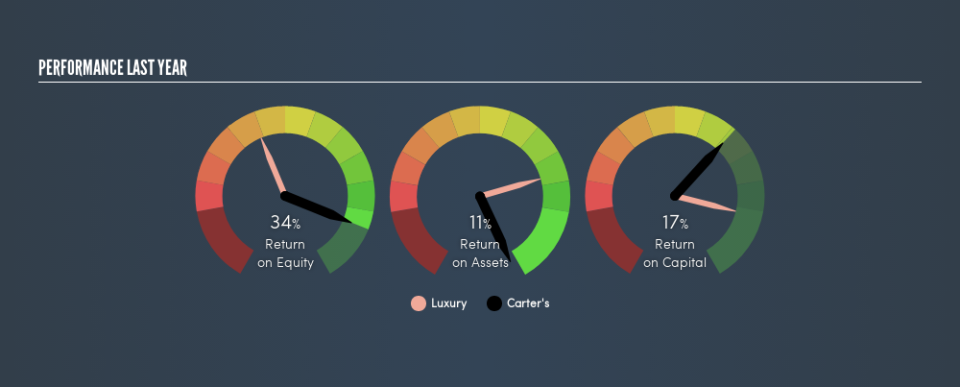Carter's, Inc. (NYSE:CRI) Earns Among The Best Returns In Its Industry

Today we'll evaluate Carter's, Inc. (NYSE:CRI) to determine whether it could have potential as an investment idea. To be precise, we'll consider its Return On Capital Employed (ROCE), as that will inform our view of the quality of the business.
First, we'll go over how we calculate ROCE. Second, we'll look at its ROCE compared to similar companies. Finally, we'll look at how its current liabilities affect its ROCE.
Understanding Return On Capital Employed (ROCE)
ROCE is a measure of a company's yearly pre-tax profit (its return), relative to the capital employed in the business. In general, businesses with a higher ROCE are usually better quality. Ultimately, it is a useful but imperfect metric. Renowned investment researcher Michael Mauboussin has suggested that a high ROCE can indicate that 'one dollar invested in the company generates value of more than one dollar'.
So, How Do We Calculate ROCE?
The formula for calculating the return on capital employed is:
Return on Capital Employed = Earnings Before Interest and Tax (EBIT) ÷ (Total Assets - Current Liabilities)
Or for Carter's:
0.17 = US$388m ÷ (US$2.7b - US$473m) (Based on the trailing twelve months to June 2019.)
So, Carter's has an ROCE of 17%.
Check out our latest analysis for Carter's
Does Carter's Have A Good ROCE?
When making comparisons between similar businesses, investors may find ROCE useful. Using our data, we find that Carter's's ROCE is meaningfully better than the 12% average in the Luxury industry. We consider this a positive sign, because it suggests it uses capital more efficiently than similar companies. Regardless of where Carter's sits next to its industry, its ROCE in absolute terms appears satisfactory, and this company could be worth a closer look.
Carter's's current ROCE of 17% is lower than 3 years ago, when the company reported a 24% ROCE. This makes us wonder if the business is facing new challenges. You can see in the image below how Carter's's ROCE compares to its industry. Click to see more on past growth.
When considering ROCE, bear in mind that it reflects the past and does not necessarily predict the future. ROCE can be deceptive for cyclical businesses, as returns can look incredible in boom times, and terribly low in downturns. ROCE is only a point-in-time measure. Future performance is what matters, and you can see analyst predictions in our free report on analyst forecasts for the company.
Do Carter's's Current Liabilities Skew Its ROCE?
Short term (or current) liabilities, are things like supplier invoices, overdrafts, or tax bills that need to be paid within 12 months. Due to the way ROCE is calculated, a high level of current liabilities makes a company look as though it has less capital employed, and thus can (sometimes unfairly) boost the ROCE. To counter this, investors can check if a company has high current liabilities relative to total assets.
Carter's has total liabilities of US$473m and total assets of US$2.7b. As a result, its current liabilities are equal to approximately 17% of its total assets. Low current liabilities are not boosting the ROCE too much.
The Bottom Line On Carter's's ROCE
With that in mind, Carter's's ROCE appears pretty good. Carter's shapes up well under this analysis, but it is far from the only business delivering excellent numbers . You might also want to check this free collection of companies delivering excellent earnings growth.
If you are like me, then you will not want to miss this free list of growing companies that insiders are buying.
We aim to bring you long-term focused research analysis driven by fundamental data. Note that our analysis may not factor in the latest price-sensitive company announcements or qualitative material.
If you spot an error that warrants correction, please contact the editor at editorial-team@simplywallst.com. This article by Simply Wall St is general in nature. It does not constitute a recommendation to buy or sell any stock, and does not take account of your objectives, or your financial situation. Simply Wall St has no position in the stocks mentioned. Thank you for reading.

